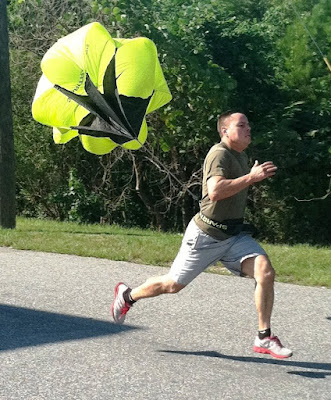During my twenty years in the Army, misinformation regarding strength training was abundant. The military is transfixed on aerobic training. For many years, the military has promoted a singular concept in which all movement revolves around aerobic fitness. Science never seemed to enter the picture, until recently. Misinformation in the military is generally handed down from generations of leaders telling subordinates, of how it was done in the past. There was absolutely no knowledge of metabolic energy pathways, or of the need for anaerobic training to develop strength and power. After completing hundreds of long distance runs and countless high repetitions of exercises, the realization that performance transference existed, resonated with me to this day. Five mile runs did not provide any cardiorespiratory benefits, when the actual tasks involved picking up heavy objects, jumping over obstacles, and sprinting to a position, that provided cover and concealment (Bompa & Buzzichelli, 2015).
Despite the fact that long distance cardio training did not enhance performance, for tasks requiring anaerobic energy pathways, the guidance was to simply run more. During the times that strength training could be conducted in a gym, the emphasis was on light resistance and high repetitions. The well indoctrinated, aerobic based leaders would tell myths that heavy weight training would cause excessive mass, slow a soldier down, and get them killed. There was no knowledge of the benefits of strength and power development. The reality was that the soldiers needed strength and power development, for many of the same reasons that athletes do. Soldiers must be able to sprint, from one position to another, while under direct fire. There is a strength requirement when soldiers must physically pick up wounded comrades, and move them to safety. Negotiating obstacles, and maneuvering through difficult terrain, can require the use of all metabolic energy pathways. But yet the focus remained steadfast. Run more and do more repetitions to maximize endurance. Picking up a wounded soldier, with body armor and gear on, is anaerobic. No amount of five mile runs will assist with that task. Because of the excessive aerobic training, overtraining symptoms became common. Sarcopenia, osteopenia, and the skinny fat syndrome were present in soldiers, across the entire Army. The lack of power and strength training not only hindered performance, but caused many health issues as well (Mientka, 2013).
When power and strength training was added into the programming, along with aerobic training, performance increased dramatically. Physical fitness test scores were raised, and actual job related tasks were performed at much higher levels. By incorporating the different metabolic energy pathways into the fitness program, the limitations of the previous programming were overcome. The aerobic based leaders continued to dismiss these science based results. The modern military is finally accepting the science, and new programs addressing power and strength are being developed. Sprinting, plyometrics, and heavy resistance training are invaluable assets to any military program. Hopefully, the days of being told to just run more, are coming to an end (Stevens, 2017).
References:
Bompa, T.O., & Buzzichelli, C.A. (2015). Periodization training for sports (3rd ed.). Champaign, IL: Human Kinetics.
Mientka, M. (2013). Long-Distance Running And Endurance Exercises May Have Limited Health Benefits. Medical Daily. Retrieved from http://www.medicaldaily.com/long-distance-running-and-endurance-exercises-may-have-limited-health-benefits-246227
Stevens, E. (2017). Go anaerobic: What it is and why to do it. Breaking Muscle. Retrieved from https://breakingmuscle.com/fitness/go-anaerobic-what-it-is-and-why-to-do-it
Despite the fact that long distance cardio training did not enhance performance, for tasks requiring anaerobic energy pathways, the guidance was to simply run more. During the times that strength training could be conducted in a gym, the emphasis was on light resistance and high repetitions. The well indoctrinated, aerobic based leaders would tell myths that heavy weight training would cause excessive mass, slow a soldier down, and get them killed. There was no knowledge of the benefits of strength and power development. The reality was that the soldiers needed strength and power development, for many of the same reasons that athletes do. Soldiers must be able to sprint, from one position to another, while under direct fire. There is a strength requirement when soldiers must physically pick up wounded comrades, and move them to safety. Negotiating obstacles, and maneuvering through difficult terrain, can require the use of all metabolic energy pathways. But yet the focus remained steadfast. Run more and do more repetitions to maximize endurance. Picking up a wounded soldier, with body armor and gear on, is anaerobic. No amount of five mile runs will assist with that task. Because of the excessive aerobic training, overtraining symptoms became common. Sarcopenia, osteopenia, and the skinny fat syndrome were present in soldiers, across the entire Army. The lack of power and strength training not only hindered performance, but caused many health issues as well (Mientka, 2013).
When power and strength training was added into the programming, along with aerobic training, performance increased dramatically. Physical fitness test scores were raised, and actual job related tasks were performed at much higher levels. By incorporating the different metabolic energy pathways into the fitness program, the limitations of the previous programming were overcome. The aerobic based leaders continued to dismiss these science based results. The modern military is finally accepting the science, and new programs addressing power and strength are being developed. Sprinting, plyometrics, and heavy resistance training are invaluable assets to any military program. Hopefully, the days of being told to just run more, are coming to an end (Stevens, 2017).
References:
Bompa, T.O., & Buzzichelli, C.A. (2015). Periodization training for sports (3rd ed.). Champaign, IL: Human Kinetics.
Mientka, M. (2013). Long-Distance Running And Endurance Exercises May Have Limited Health Benefits. Medical Daily. Retrieved from http://www.medicaldaily.com/long-distance-running-and-endurance-exercises-may-have-limited-health-benefits-246227
Stevens, E. (2017). Go anaerobic: What it is and why to do it. Breaking Muscle. Retrieved from https://breakingmuscle.com/fitness/go-anaerobic-what-it-is-and-why-to-do-it
Eric Dempsey
MS, ISSA Master Trainer














